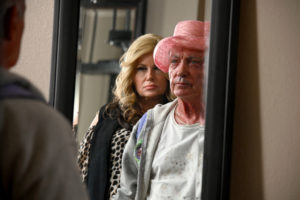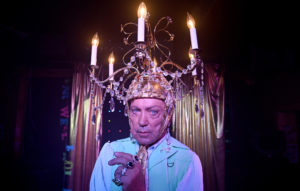For those people, like myself, who are seeing Udo Kier for the first time in Swan Song (2021), you will be shocked to discover just how diverse and eclectic his vast filmography is. The German-born character actor has dove into characters as demented as Dr. Frankenstein and Dr. Jekyll and worked with filmmakers as notable as Lars von Trier, Gus van Sant, and Alexander Payne. His turn as the retired gay beautician and former drag queen Patrick “Mr. Pat” Pitsenbarger is delightful enough without a proper grasp on these credits, but that additional knowledge only serves to make the performance that much more remarkable. Not just in the sense that it’s one of the only times he’s been cast as a headliner, but also in that his more subdued presence here adds a bittersweet texture to the film’s delightful spark.
Filmed in and set in Sandusky, Ohio — the hometown of both writer-director Todd Stephens and yours truly — Swan Song is fittingly small scale, yet a glamorous tribute nonetheless to the real-life Pitsenbarger, a local gay legend. It’s also a film that’s wise enough to shine a light on the forces that sadly force such legends into obscurity; we open on Pat as his best years have long since been forgotten by almost everyone except himself. He’s wallowing away in a decrepit nursing home with nothing but More cigarettes and the monotonous habit of neatly folding cafeteria napkins to keep him company as his fate slowly creeps up on him.

Pat is more than content to live his remaining days in solitude until he receives a visit from a lawyer representing the estate of the recently deceased Rita Parker Sloane (Linda Evans), a former client whose last wish was that Pat do her hair and makeup for the funeral. Though Pat initially rejects the offer and pay, and swiftly so — the two had a tremendous falling out in connection to Pat’s fade from the local spotlight — he eventually musters the courage to break free from his surroundings and head back into town in what amounts to another classic “one last job” trajectory.
Swan Song doesn’t spend a ton of time divulging what it is that causes Pat to have such a quick change of heart, but its rather loose structure affords Stephens enough space to bring Pat back to the town that abandoned him in his prime. It’s apparent very quickly that Pat’s days in confinement have left him out of touch with the changes that have befallen Sandusky, a notion the film milks for everything it’s worth in ways both humorous and heartbreaking. From smoking outdated cigarettes to walking downtown in a pink hat and green leisure suit to riding down a busy street in a motorized scooter, Kier completely owns the role and elevates what could otherwise have been a rather generic redemption story where the journey is more important than the destination.

As a once key figure of the town’s gay community, Pat has come back to stake a claim on what once was his, and Kier shines with some very on-point sardonic comedic timing that keeps the film from swaying too far into overt drama, though he nails these darker moments just as well. Grappling with the trauma of losing his partner among many others, losing business to a former apprentice (Jennifer Coolidge), and the regrets that come with being one of the last relics of a bygone era, Pat holds onto these wounds throughout, reminding those he meets who he once was and why he is who he is now. He’s not someone Stephens wants us to pity or mourn so much as someone to remember as the kind of person Kier plays him as: a flamboyant, yet caring man who was proudly himself and could find the humorous light at the end of the tunnel. Thus, he sets out to make a film akin to the kind of memoir his local hero would like to see.
Despite how distant Pat remains from the 21st century, he unabashedly has no interest in fitting in. He has the knowledge of knowing he doesn’t have enough time to fit in, as sad as it is. You can read the astonishment all over Kier’s face when he sees just how well the new members of his city are willing to treat him now that sociocultural values have improved with time. It’s refreshing to see him welcomed back into the spotlight, though his redemption is bittersweet since he doesn’t have the extended number of days to enjoy it the way he, and we, would like him to.

Swan Song is not the kind of work that degrades its subject by talking down to an audience trying to understand who he was. Just as it doesn’t mourn him, it doesn’t embarrass him because we are learning about him just the same as the residents of Sandusky are. When it’s funny, we aren’t laughing at the character so much as we are at the circumstances that make him, smiling through the pain all the while. When it’s uplifting, such as when Pat goes for broke performing a drag routine at a bar on the verge of foreclosure, it’s not so much because of him as it is the notion that someone like him is trying so hard to reclaim a much-needed part of themselves.
Even when Swan Song occasionally loses sight of the end goal, it does so with at least some semblance of purpose, especially since its conclusion feels all too brief and unsatisfying, suffering in comparison to what came before it. Then again, Stephens would have us believe that Pat’s life was itself too brief and the until-now limited spread of his legacy unsatisfying. In taking the time to ensure that at least some wrongs are righted, his handling of the narrative, in turn, ensures that nothing is ever at Pat’s expense, even if it is at everyone else’s. Pat has nowhere to go but up while he rages against the dying of the light.

Comments